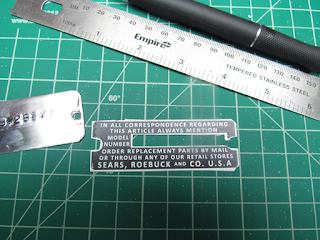 You may recall when I de-rusted the drill press base via electrolysis, some of the lettering on the silk screened number plate was removed.
You may recall when I de-rusted the drill press base via electrolysis, some of the lettering on the silk screened number plate was removed.You can see it on the left. I'm still annoyed with myself for leaving the plate on the base but there you have it.
I pondered this problem for a while and decided to make a decal recreation of the plate.
I've done this for effect pedals, so I was familiar with the process.
I scanned the plate and opened the scan in Photoshop. I had also found some images online of plates from similar drill presses. None of those plates were in great shape (and the photos were marginal), but they would have to do.
I took two approaches to recreate the label. At first, I tried copying letters that were clean and sharp and pasted them where I needed them. For example, I found one clean "C" and used that for all of the C's.
This worked ok, but it was tedious and I just didn't have good versions of certain letters ("K" for example).
So I did some experimenting and found a modern font that was as close match for the font that Sears used. I carefully resized it and changed settings including the kerning and width and got a reasonably close facsimile. All of the guidelines you see in the image above were necessary to get everything aligned properly.
Here's the final version of the label in Photoshop.
You will note that I put my copyright over the label in green. I have had several images from the blog appropriated and wanted to prevent it. This work represents hours of my time and, sorry, it's copyrighted.
Just because it's on the interwebs doesn't mean it's free! Most folks (including me) will help you out if you ask nicely. But just taking it is a violation of copyright law.
Lecture over.
Now let's print and apply the decal.
The original screen was black and was done so that the lettering is actually the silver surface of the plate.
I used clear laser decal paper to get the same look. First I had to strip the old paint off, and sand the plate so it was clean.
Here's the plate after cleaning it up.
I used 120 through 600 grit paper, and polished the tarnished area between the model numbers with a small felt buffer on my Dremel using Mother's Mag and Aluminum polish.
I printed a bunch of labels in case I made some goofs.
I found that the black print wore off on a couple of decals. I don't know if it was the printer or the paper. I have found a source for Papilio laser decal paper, and I plan to try that in the future.
I cut the best looking decal off the sheet.
Note that I tried to trim the opening in the center and the two curves at the end as closely as possible. I probably could have gotten even closer, but I didn't want to cut into the label accidentally!
Soak the decal in warm water for 30-40 seconds until it starts to come free from the backing.
While the decal was soaking, I put some Micro Set onto the plate.
This stuff helps the decal adhere to the surface. Not critical, but I like to use it.
Position the decal, and gently apply Micro Sol setting solution. This softens the decal and makes it take the shape of the surface. In this case, it's flat (duh), but the Micro Sol helps the decal look painted onto the surface. It's really great for curved surfaces on models.
I mentioned some of the print that came off the decal. I found some spots and touched them up with black enamel model paint.
I must be nuts. Not like anybody will really notice once the plate is back on the base.
Here's the finished plate.
I'm going to hit with with a couple of light coats of clear poly to protect it before I install it.
The complete restoration saga
Part 1 - Beginning
Part 2 - Electrolysis to Remove Rust
Part 3 - Grinding to Remove Rust
Part 4 - Leveling Base Table
Part 5 - Recreating Model Number Label
Part 6 - Refinishing Base
Part 7 - Removing Motor
Part 8 - Motor Disassembly
Part 9 - Motor Bearing Replacement
Part 10 - Start Capacitor and Motor Reassembly
Part 11 - Removing Threaded Jacobs Chuck
Part 12 - Spindle Removal
Part 13 - Quill Disassembly
Part 14 - New Quill and Spindle Bearings
Part 15 - Engine Turned Aluminum Trim Proof of Concept
Part 16 - Engine Turned Aluminum Trim
Part 17 - Cleaning and Polishing Hardware
Part 18 - Jacobs 633C Drill Chuck Restoration
Part 19 - Cleaning and Polishing Column
Part 20 - Reassembly Begins
Part 21 - Restoration Completed














Part 4 was supposed to be about leveling of table but instead it’s duplicate of part 5. Look forward to reading part 4 after you update it. Thanks in advance for posting part 4. Thanks also for posting your step by step process of restoring such a classic.
ReplyDeleteThis comment has been removed by the author.
ReplyDeleteCould you please tell me what you used for the decal transfer label? Can you email me back at ccrannel@comcast.net
ReplyDelete